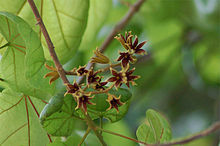Buddha Nut
| Buddha Nut | ||||||||||||
|---|---|---|---|---|---|---|---|---|---|---|---|---|

Buddha nut ( Pterygota alata ), illustration |
||||||||||||
| Systematics | ||||||||||||
|
||||||||||||
| Scientific name | ||||||||||||
| Pterygota alata | ||||||||||||
| ( Roxb. ) R.Br. |
The buddha nut ( Pterygota alata ) is a species of tree from the subfamily of the sterkulia or stink tree family. It is also known in Central Europe for its seed pods .
description
Pterygota alata is an evergreen tree that reaches a height of up to 30 meters. Its bark is gray or brownish gray, the bark of the twigs is initially yellowish hairy.
The stipules are sharply pointed and are shed early. The alternate leaves are simple and crowded at the branch ends. The petiole becomes 5 to 15 centimeters long. The leaf blade is heart-shaped or broadly ovate, 13 to 35 inches long and 10 to 17 inches wide. The top and bottom are initially hairy. The leaf margin is almost whole, the leaf base is heart-shaped or truncated, the leaf tip rounded to pointed or blunt.
The brown-red to purple, unisexual flowers with a simple flower cover are loosely distributed in axillary panicles and are almost sessile. The fleshy, thick calyx is bell-shaped and has 17 to 20 millimeters long, ruler-lanceolate and flabby lobes with dense hair on the outside, the petals are missing. In the male flowers, the stamens are fused in a weakly hairy synandrium, which reaches about half the length of the calyx. About 20 dust bags are arranged spherically on its tip . Not fully developed carpels can be seen. The female flowers have short staminodes. The upper ovary is spherical and downy hairy, with five short, curved and slightly hairy styluses with small, elongated scars . 40 to 50 ovules are formed in three rows per carpel . Flowering time is from February to March.
The fruits are lignified, almost rounded and somewhat flattened, about 12 centimeters in size, slightly hairy, brownish follicles that open into two lobes. Each fruit contains a large number of elongated, flat, about 7 centimeters large, unilaterally winged seeds.
The number of chromosomes is 2n = 40.
distribution
The distribution area of the species extends from India and China to Bangladesh , Vietnam and Thailand to the Philippines. There it thrives in open forests.
Systematics
Pterygota alata is a kind of the genus pterygota that in the family of the Malvaceae (Malvaceae) of the subfamily of sterculioideae is assigned (Sterculioideae).

use
Trees of the species are planted to provide shade in gardens and along roadsides. The seeds are said to be edible and are also used as an opium substitute . An oil is also obtained from them.
The non-durable wood is light and soft.
Individual evidence
- ↑ Detail picture of the flower at Botany Department of University of Hawai'i at Mānoa.
- ↑ a b Pterygota alata. In: Flora of Pakistan. eFloras.org, p. 23 , accessed December 18, 2010 (English).
- ↑ a b Pterygota alata. In: Flora of China Vol. 12. eFloras.org, p. 303 , accessed on December 18, 2010 (English).
- ^ Pterygota alata at Tropicos.org. In: IPCN Chromosome Reports . Missouri Botanical Garden, St. Louis
- ^ Pterygota alata. In: Germplasm Resources Information Network (GRIN). United States Department of Agriculture, accessed December 18, 2010 .
Web links
- Pterygota alata at Useful Tropical Plants.
